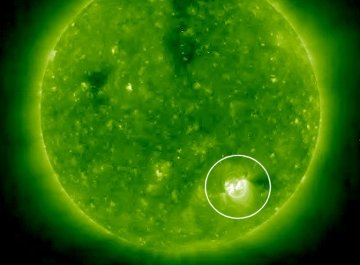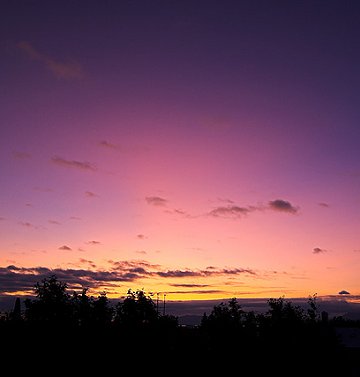| LAUNCH DELAYED: Space shuttle Endeavour's launch to the International Space Station has been postponed until Sunday, July 12th, to give technical teams more time to evaluate lightning strikes at the launch pad that occurred during thunderstorms Friday. Liftoff is scheduled for 7:13 p.m. EDT. AROUND THE BEND: The biggest sunspot in two years, sunspot 1024, has rotated over the sun's western limb and is no longer visible from Earth. But that doesn't mean the sunspot has disappeared. Here it is in an ultraviolet photo taken just a few hours ago by NASA's STEREO-A spacecraft: 
STEREO-A is stationed over the sun's western horizon where it can monitor sunspots no longer visible from Earth. The spacecraft will track sunspot 1024 for as much as four more days, gathering valuable data on the sunspot's rate of growth or decay. Indeed, if the sunspot can hold itself together for only two more weeks, the sun's rotation will carry it around to face Earth once again. Stay tuned for updates from around the bend. PURPLE SUNSETS: High up in the stratosphere, sulfur dioxide emissions from Russian's Sarychev Peak volcano have circumnavigated the northern hemisphere. As a result, purple sunsets are appearing at all longitudes. Fredrik Holm photographed this specimen last night in Reykjavík, Iceland: 
"The sky was nicely purple during the hours of sunset and sunrise," says Holm. "Ash from Sarychev Peak was clearly influential." How do volcanoes turn the sky purple? Fine, sulfurous aerosols in the stratosphere scatter blue light. Blue mixes with ordinary sunset red to produce the lavender hue. It has been a full month since Sarychev Peak erupted and the purple is still being sighted on a regular basis from Russia, Canada, Iceland, northern-tier US states and many countries in Europe. Browse the gallery for more examples. UPDATED: 2009 Sarychev Sunset Gallery
[See also: 2008 Kasatochi Sunset Photo Gallery]
2009 Noctilucent Photo Gallery
[previous years: 2008, 2007, 2006, 2005, 2004, 2003]
Explore the Sunspot Cycle | 
